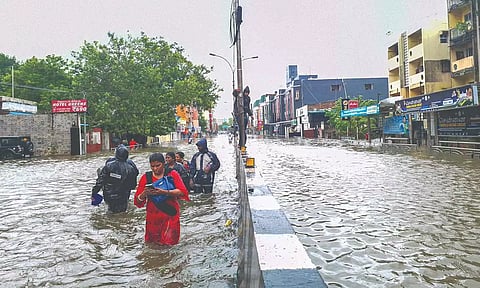

CHENNAI: With almost every street in every locality of the metropolis going under water for several days during the Michaung Cyclone, data compiled by the Revenue and Disaster Management department has revealed that city streets held around 67 tmc of stagnant water.
The disclosure was made during a workshop of government officials titled ‘Learnings from the Twin Natural Calamities of December 2023 and the Way Forward’ held at the Secretariat on Saturday. The meeting focused on floods in southern districts along with the Chennai floods.
During the workshop, the participating officials, who were directly and indirectly involved in the flood mitigation works, were told that the city received 47cm of rainfall in 48 hours.
For better understanding, Cholavaram, Redhills, Kannakottai Thervoykandigai, Chembarambakkam and Poondi - lakes that supply drinking water to Chennai have a total storage capacity of only 11.75 tmc. Moreover, 67 tmc is around two-third of total storage capacity of Mettur Dam, which is 93 Tmc. Speaking at the workshop, chief secretary Shiv Das Meena said that the workshop was planned to be conducted in the third week of December after the Chennai floods, but postponed due to floods in southern districts.
“The objective of the workshop is to discuss better ways to manage such disasters,” he said.
Decentralising the emergency response:
Meanwhile, the state government has proposed to establish a decentralised emergency response system with graded empowerment to minimise the response time and maximise the efficacy of the risk governance mechanisms.
The government will also take up recovery and reconstruction of critical and lifeline infrastructure and build them back as climate resilient infrastructure apart from taking up multi hazard disaster risk mitigation across the state.
During the workshop, discussions were held on multi hazard early warning, search, rescue and evacuation as a part of response, relief distribution, recovery and reconstruction, community engagement and media relationship.
According to the workshop note, the extreme weather events of December 2023 were stark reminders that the impact of climate change-related disasters are becoming massive and interconnected, and cascading in nature.